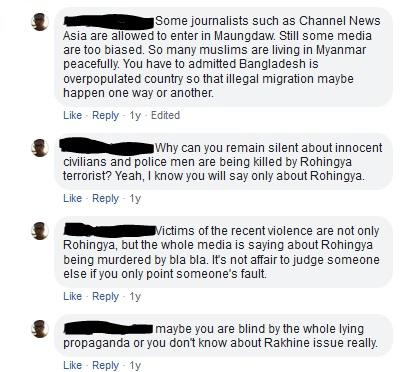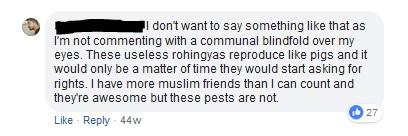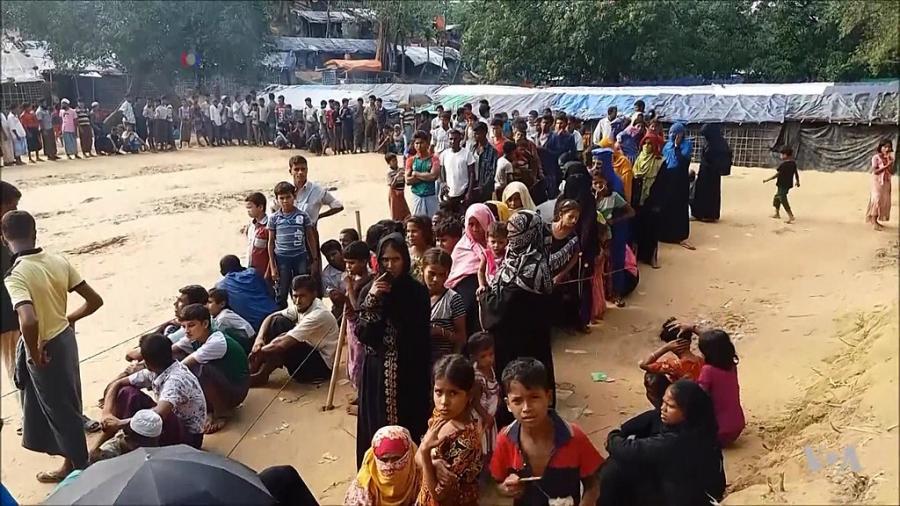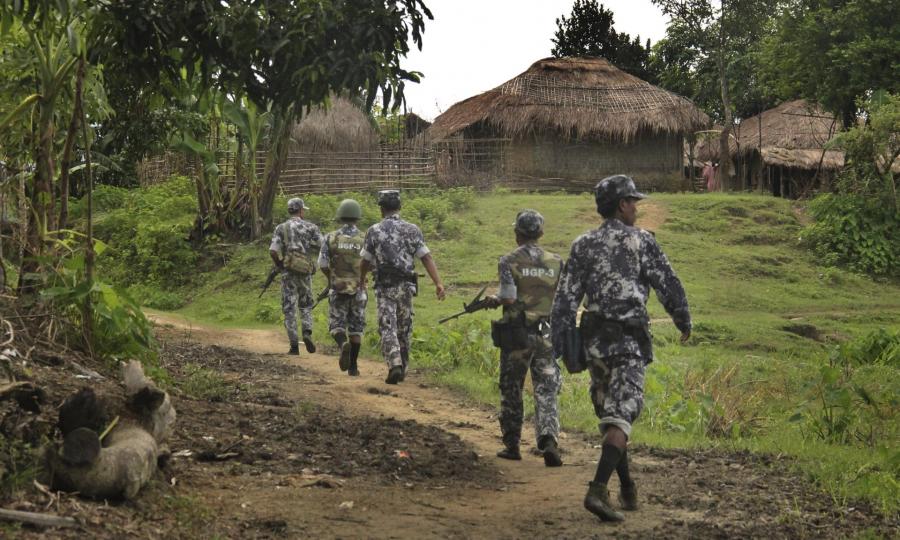
Facebook and the Rohingya genocide deniers
Facebook seems to have played an important role in denying the Rohingya Genocide. This article digs deeper into this phenomenon and tries to answer if and how Rohingya genocide deniers have used Facebook to spread their narratives, and what kind of arguments do they used to support their claims?
The Rohingya Genocide and the post-truth era
We live in a post-truth era. An era “in which objective facts are less influential in shaping public opinion than appeals to emotion and personal belief.” (Oxford Dictionaries, n.d.) Within this climate of an enormous indifference to the truth itself, it is very important for academics, among others, to turn their attention to the main sources of misinformation, fake news and propaganda: social media.
Facebook, Twitter and other similar “new institutions have transformed the nature of communication, putting out vast masses of unedited, undigested, uncontrolled information and, more importantly, misinformation out into the public arena.” (Evans, 2017) So, it comes as no surprise that in August 2018, when the United Nations issued a report alleging that the Myanmar military intentionally carried out genocide against the Rohingya Muslim minority in Rakhine state, they also challenged the role of Facebook in connection to these events (Newton, 2018):
“The role of social media is significant. Facebook has been a useful instrument for those seeking to spread hate, in a context where, for most users, Facebook is the Internet. Although improved in recent months, the response of Facebook has been slow and ineffective.” (Human Rights Council, 2018: p. 14)
This report was a continuation of the UN's accusations, which began in spring 2018, “when the chairman of the U.N. Independent International Fact-Finding Mission on Myanmar told reporters that Facebook had played a 'determining role' in spreading hate speech.” (Newton, 2018) Although Facebook has done a lot since to remove profiles and posts promoting hate speech and Rohingya genocide denials, it did not put an end to this practice. Facebook still remains the main platform for haters and deniers alike to spread their message, especially through propaganda, fake news, and social media bubbles.
Nowadays, just one Facebook post or Tweet can cast doubt on or even change an entire narrative of events
What is interesting in the case of Rohingya genocide denials on Facebook is that there are actually two separate dynamics that have emerged in recent years. On the one hand, we have the denial on the part of individual Facebook users, who operate in a social media bubble where likeminded people gather to share their own beliefs, opinions and experiences.
On the other hand, there is the deliberate denial by Myanmar’s military officials, which is very systematic and organized. In this case Facebook served as a governmental instrument spreading fake news, propaganda, hate, and violence in order to justify the actions against Rohingya Muslims. Even though their arguments and motivation behind the denials might vary, both groups nevertheless see Facebook as the main platform through which “to put their obnoxious opinions before the public as if they were statements of the truth.” (Evans, 2017)
The aim of this paper is to explore how Rohingya genocide deniers use Facebook to spread their narratives, and what kind of arguments they use to support their claims. In order to analyze this, concepts and theories about post-truth, the production of knowledge, and conspiracy theories will be used in combination with literature on genocide denials.
The social media bubble of Rohingya genocide denial
“Today, access to informative content, as well as its immediacy and volume, has no precedents. The impact of digitalization in the world of communications has brought about a revolution in a way that people can produce information themselves.” (Gooch, 2017: p. 14)
This new era has ended the state's monopoly over the production and legitimization of knowledge. This has allowed other parties (individuals, marginalized groups, laymen, etc.), who are maybe less legitimate to also produce knowledge and contribute to this practice. Especially on Internet forums and social media platforms, knowledge of different orders of visibility is intertwined (Hanell and Salö, 2017). This environment has also allowed marginalized knowledge to migrate from the fringes of society to the mainstream. After all, misinformation, fake news, conspiracy theories and even genocide denials are not new phenomena; however, their visibility and impact on individuals and society alike changed drastically with the rise of the Internet.
What is so interesting and at the same time alarming about this post-truth era is the interpretation and relevance of the truth. “[P]ersonal beliefs — which for many are irrefutable — have gained strength in the face of logic and facts, and have become established as assumptions shared by society, causing bewilderment in public opinion.” (Llorente, 2017: p. 9) Within this climate, traditional media are losing authority over knowledge production due to the popularity of social media platforms like Facebook, Twitter and many more. Nowadays, just one Facebook post or Tweet can cast doubt on or even change an entire narrative of events, even the narrative of a genocide.
Since online users “are now master and authors of their own informative environment” (Prego, 2017: p. 20), traditional media and television no longer serve as gatekeepers. However, a new problem has arisen: isolated bubbles “in which people are exposed only to opinions and information that conform to their existing beliefs.” (Merriam-Webster, n.d.)
In researching Rohingya genocide denial, the best approach proved to be to simply open Facebook and type the words “Rohingya genocide” into the search box. Within the first few search results I landed right in the middle of a social media bubble of Rohingya genocide denials. The more I read, the more the denial bubble expanded. Once you are in this bubble of denial, you can easily get lost in it.
Articles that try to establish the real facts of the Rohingya genocide, in direct opposition to denial narratives, are immediately criticized and discredited by deniers to confirm that their own version of events is the only truth. One Facebook user left a similar observation under a Rohingya genocide article, shared by Dhaka Tribune on Facebook (Dhaka Tribune, 2017):

Yet these comments do not discourage deniers. In fact, they only make them even more determined to prove their point. For instance, just a few comments below the same article, deniers show up to express their hate about the Rohingya genocide narrative. Any attempt to call into question their opinion just bounces off their denial bubble. Thus, the denier's belief remains unshaken.

In the digital era where information is supposed to be available to everyone, these bubbles are actually a huge step backwards. They are “the perfect breeding ground for spreading fake news—nowadays called post-truth.” (Prego, 2017: p. 21) Since there is no need to fact-check reality on social media, users who receive or share fake news accept it as true, which only reinforces their beliefs. (Ibid)
As the above examples prove, the facts are not important for Facebook users who deny the Rohingya genocide. Their indifference to the truth creates a new form of knowledge; a knowledge that is based on their opinions, beliefs and very often their experience. Here is a very good example where the user’s experience takes precedence. It was posted under an article on Facebook exposing fake news about Rohingya Muslims (The Logical Indian, 2018):

It is very hard to argue with people who use their own experience as evidence to produce knowledge. Since they are so convinced that their version of the events is the only truth, any other real fact or evidence brought to them would be just meaningless. After all, as they say: Seeing is believing.
Conspiracy theories, scapegoating and white nationalism
What becomes evident while reading the various Facebook threads related to this issue is that many social media users involved in these discussions cannot distinguish anymore between facts and fiction. A few of the comments can even be categorized as conspiracy theories. The main narrative of conspiracy theories is that a special kind of knowledge is known only to a few privileged people, in this case the legitimate people of Myanmar, while the rest of the world is manipulated by international media that hides the real truth. Here is just an example of such a comment found under a video clip posted on Facebook (Rohingya Today, 2018):

Nowadays many people tend to think that there is a hidden plot carried out by “them” to control “us”
The biggest issue with conspiracy theories nowadays is that they do not necessarily exist only on the fringes of society. Due to rapid technological developments and the rise of the Internet, where likeminded people are able to share their ideas with each other much more easily, conspiracy theories have entered mainstream culture as well (Barkun, 2016). These theories' higher order of visibility also makes such knowledge seem more truthful, and former skeptics can become more convinced of their legitimacy (Hanell and Salö, 2017).
Facebook flagging these denial comments as most relevant or mostly viewed also adds to their credibility.
A very troubling implication of conspiracy theories becoming valid explanations is the fact that many people tend to think there is a hidden plot carried out by “them” to control “us”. This will, however, not lead to any social changes, but rather render people politically passive through trying to find scapegoats for every social issue (Barkun, 2016).
“The violence against the scapegoat must […] be seen as 'good violence', in the sense that for the ritual to be effective, the attackers must be honestly convinced of the rightfulness of their accusations and the legitimacy of the violence afflicted on their targets.” (Van Dijk, 2009: p. 7)
In the case of Rohingya genocide denial, the scapegoats are the Rohingya Muslims themselves. In fact, the deniers believe that violence against the Rohingya Muslims is perfectly justified since they are seen as the root to all the problems in Myanmar’s society.

However, many deniers feel the need to support these arguments even more by posting additional links in their comment threads. One of these links found under an Asia Times article(Asia Times, 2017) leads to a website called “Defend Europa”. At first glance this website seems pretty legitimate since it resembles mainstream news outlets. Yet, upon closer examination it becomes clear that it actually promotes nationalism, racism and hatred, especially towards Muslims (Defend Europa, n.d.).
The above mentioned Facebook link actually opens up an article about Rohingya Muslims that can be described as a case of interpretative denial (Cohen, 2002: p. 7). It was written by "Alex", who claims to be an Italian student and political activist. This article portrays Rohingya Muslims as the real perpetrators rather than victims of genocide, which is a classic case of scapegoating. The victims are perceived as the real problem; therefore, their expulsion is the only way to peace. Here is just an example of the author's interpretation of the situation in Myanmar:
“The Myanmar government is certainly not the pillar of democracy or enlightenment but what is happening in Myanmar is not some evil ethnic cleansing based on racism but a firm and strong response to the perpetrated violence of a small minority that refuses to live in peace. Clearly, civilians are getting caught in the crisis but the jihadist knew this would happen and Muslims aren’t new to these tactics, using civilians as human shields. The Rohingya are not innocent, the Burmese people are defending themselves, their country, their identity, their religion, their existence.” (Alex, 2017)
Interestingly the author does not deny that the genocide happened but interprets the facts rather differently: “[It] is not some evil ethnic cleansing based on racism” (Alex, 2017), but something totally different. In fact, the arguments he uses to explain the motives behind the Myanmarese government’s actions can be also understood as rationalizing the events (Cohen, 2002: pp. 7-8). In his opinion, the government's “firm and strong response” is just a logical reaction to a violent minority that “refuses to live in peace.” (Alex, 2017) The fact that civilians were killed does not carry any moral implications for the author. This is a very common defense mechanism used by implicatory deniers (Cohen, 2002: p. 8).
“The spread of anti-Rohingya misinformation across Facebook was not merely organic, but the result of systematic and covert exploitation by the military”
The above-mentioned article is written in an academic style and the arguments the author uses can sound pretty convincing, especially to people who do not care about historical facts or the genocide evidence gathered by organizations like the UN, ICC, or mainstream media. Yet what is even more concerning is that the arguments used in this article reflect a widespread negative attitude towards Muslim people in general. These attitudes are very similar to the ideas of white nationalists. This ideology has many passionate followers on social media.
Many are convinced that all Muslims are a threat. Therefore, any atrocities committed against Muslims are perceived by these people as justified and necessary to preserve white supremacy (Maly, 2019). This ideology is also very similar to conspiracy theories. As it was already pointed out, conspiracy believers think that there is a group of people with a hidden agenda who run the world. In the case of white nationalists, Muslims are seen as the enemy who is trying to take over the world and ruin the "ethnic purity" of white people (Ibid).
Since the white nationalists’ ideology plays nicely into the conspiracy theory about Muslims being the real threat, it serves as yet another idea which helps reinforce and confirm the beliefs of online Rohingya genocide deniers. Thus, their denial bubble remains intact, while the truth and objective facts become irrelevant.
The military's secret Facebook propaganda
Besides the fact that any kind of online misinformation poses a serious threat to the truth about the Rohingya genocide, what makes this narrative even more troubling is that “the spread of anti-Rohingya misinformation across Facebook was not merely organic, but the result of systematic and covert exploitation by the military.” (Douek, 2018) According to reporting done by The New York Times in October 2018, Myanmar’s military has systematically used Facebook for years as an instrument to carry out the genocide of Rohingyas and at the same time to cover it up. Considering the fact that Myanmar is a country where Facebook synonymous with the Internet, this carefully organized narrative embedded itself into the everyday lives of citizens (Mozur, 2018).
Based on information gathered by The New York Times (Mozur, 2018), the military’s Facebook campaign was a highly secretive operation. It employed more than a hundred military officials and staff members who worked in shifts to create “troll accounts and news and celebrity pages on Facebook and then flooded them with incendiary comments and posts timed for peak viewership.” (Ibid) Additional attention was dedicated to criticizing and discrediting all kinds of Facebook posts and information that might oppose the official military narrative about the Rohingya genocide (Ibid).
Many of these fake profiles, blogs, and pages were removed by Facebook following the UN report, which alleged the indirect involvement of Facebook in the events (Newton, 2018). Nevertheless “the breadth and details of the propaganda campaign — which was hidden behind fake names and sham accounts — went undetected.” (Mozur, 2018)
One of the main techniques used in the military's Facebook campaign involved setting up and carefully maintaining fake profiles and blogs of Burmese entertainers, celebrities, and prominent state figures. One such profile belonged to a fake beauty blogger who frequently propagated information of military nature. Many of these profiles and blogs managed to attract more than a million followers. These Facebook pages soon became the epicenter of fake news and misinformation (Mozur, 2017). “Troll accounts run by the military helped spread the content, shout down critics and fuel arguments between commenters to rile people up. Often, they posted sham photos of corpses that they said were evidence of Rohingya-perpetrated massacres.” (Ibid)
Myanmar’s military managed to weaponize social media in order to commit mass atrocities and cover it up by exploiting their own people for it
According to Hanell and Salö, certain types of practices and knowledge are perceived as more credible and legitimate than others due to social power structures that stratify knowledge into orders of visibility. What is considered to be more credible and legitimate becomes more visible than others. The knowledge that is produced and considered credible is therefore embedded in the power structure of a society, which can carry the interests of the people, groups or individuals that created it. Thus, certain people are considered to have more power to talk about certain topics than others do.
In this case not all types of knowledge are equally accessible or visible to everyone. For instance, marginalized groups who do not participate in the power structures are also unable to participate in the production and legitimization of knowledge. According to this, only people with certain types of power, such as public authorities or experts, are able to claim knowledge of a certain topic and introduce their knowledge as credible and universal. The rise of the Internet, however, allowed people to both access all kinds of information and at the same time produce, negotiate, and apply knowledge to concrete situations (Hanell and Salö, 2017).
However, in the case of Myanmar, the Internet was actually exploited by the military to systematically manipulate social media content and spread fake news for years. The knowledge produced by these practices carries the interests of military officials. Therefore, they hold a huge power over the production and distribution of the official narrative about the Rohingya genocide.

Due to the massive resources at hand and its unique power position in the production of knowledge, the Myanmarese military managed to carry out the ethnic cleansing of Rohingyas and at the same time sustain a structured online denial about its actions. This kind of deliberate, intentional denial on an organized level is built into the official rhetoric of the state (Cohen, 2002: p. 10). “The social conditions that give rise to atrocities merge into the official techniques for denying these realities – not just to observers, but even to the perpetrators themselves.” (Ibid)
According to The New York Times article (Mozur, 2017), one of the most dangerous parts of the campaign was carried out in 2017, which coincides with the mass exodus of Rohingya Muslims from Rakhine state. During this online campaign rumors were spread on two fronts: to Buddhist and Muslim groups. At first, private messages were sent out from fake profiles to Buddhist followers alleging that the Muslims are planning an attack on them. Second, fake news about Buddhist anti-Muslim protests were distributed to Muslim Facebook communities. (Ibid) “The purpose of the campaign, which set the country on edge, was to generate widespread feelings of vulnerability and fear that could be salved only by the military’s protection.” (Ibid)
What is most shocking about all of this is that Myanmar’s military weaponized social media in order to commit mass atrocities and covered it up by exploiting their own people. They achieved this by playing on people’s emotions: “[i]f there are ideas, stories, reports that cause impact and arouse emotions, people will react.” (Weissman, 2017: p. 47) This once again proves that the post-truth era, where emotions have precedence over facts, poses a serious threat not just to the truth but to democracy itself.
References
Alex. (2017). The lies behind the innocence of Rohingya Muslims.
Asia Times. (2017). The true origins of Myanmar’s Rohingya.
Barkun, M. (2016). Conspiracy theories as stigmatized knowledge. Diogenes: pp. 1-7.
Cohen, S. (2002). States of denial: Knowing about atrocities and suffering. Cambridge: Polity.
Defend Europa. (n.d.). About us.
Dhaka Tribune. (2017). Malaysia PM claims he was able to convince Trump on Rohingya crisis.
Douek, E. (2018). Facebook’s role in the genocide in Myanmar: New reporting complicates the narrative.
Evans, J. R. (2017). “Denial”: How to deal with a conspiracy theory in the era of ‘post-truth’.
Gooch, E. (2017). In Pursuit of the Truth. UNO. The post-truth era: Reality vs. perception. 17: pp. 14-15.
Hanell, L. and L. Salö (2017). Nine months of entextualizations. Discourse and knowledge in an online discussion forum thread for expecting parents. In Kerfoot, Caroline and Kenneth Hyltenstam (eds.) Entangled discourses. South-North orders of visibility. London: Routledge: pp. 154-170.
Human Rights Council. (2018). Report of the independent international fact-finding mission on Myanmar (Report No. A/HRC/39/64).
Llorente. A. J. (2017). The post-truth era: Reality vs. perception. UNO. The post-truth era: Reality vs. perception. 17: p. 9.
Maly, I. (2019). White terrorism, white genocide and metapolitics 2.0.
Medrán, A. (2017). In the kingdom of post-truth, irrelevance is the punishment. UNO. The post-truth era: Reality vs. perception. 17: pp. 33-35.
Merriam-Webster. (n.d.). Filter bubble.
Mozur, P. (2018). A genocide incited on Facebook, with posts from Myanmar’s military.
Newton, C. (2018). It took a genocide for Facebook to ban a country’s military leadership.
Oxford Dictionaries, (n.d.). Post-truth.
Pina, C. (2017). True Friends: Legal Limits of Fake News. UNO. The post-truth era: Reality vs. perception. 17: pp. 41-43.
Prego. V. (2017). Informative bubbles. UNO. The post-truth era: Reality vs. perception. 17: pp. 20-21.
Rohingya Today. (2018). Rohingyas need international protection.
Scott, J. W. (1991). The evidence of experience. Critical inquiry. 17 (4): pp. 773-797.
The Logical Indian. (2018). Fact check: Gory video of Rohingya Muslims slaughtering hindus & selling their bodies is fake.
Van Dijk, J. (2009). Free the victim: A critique of the Western conception of victimhood. International review of victimology. 16 (1): pp. 1-33.
Weissman, I. (2017). Truth, transparency and storytelling versus truth. UNO. The post-truth era: Reality vs. perception. 17: pp. 46-47.